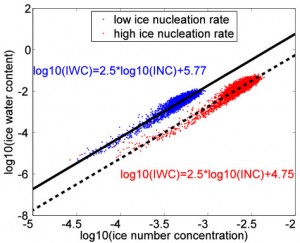![]() The Michigan Tech News story “Beyond Silicon: Transistors without Semiconductors” has been picked up and shared by several news outlets.
The Michigan Tech News story “Beyond Silicon: Transistors without Semiconductors” has been picked up and shared by several news outlets.

Minimalist model of ice microphysics in mixed-phase stratiform clouds
Fan Yang
Advisor: Raymond Shaw
Mixed-phase clouds, which can exist days even weeks, are frequently observed in the Arctic region where they play an important role in the radiation balance. Observations also show that ice particles precipitate from these clouds nearly all time. The question of whether persistent ice crystal precipitation from supercooled layer clouds can be explained by time-dependent, stochastic ice nucleation is explored using an approximate, analytical model, and a large-eddy simulation (LES) cloud model. The updraft velocity in the cloud defines an accumulation zone, where small ice particles cannot fall out until they are large enough, which will increase the residence time of ice particles in the cloud. Ice particles reach a quasi-steady state between growth by vapor deposition and fall speed at cloud base. The analytical model predicts that ice water content (wi) has a 2.5 power law relationship with ice number concentration (ni). wi and ni from a LES cloud model with stochastic ice nucleation also confirm the 2.5 power law relationship. The prefactor of the power law is proportional to the ice nucleation rate, and therefore provides a quantitative link to observations of ice microphysical properties. Figure 1 shows LES results for two ice nucleation rates: Blue points correspond to low ice nucleation rate and red points to high ice nucleation rate. It’s clearly to see that points follow the 2.5 power law as our analytical model expected. The intercept shift predicted by the minimalist model is 1.05, which is very close to the best fitted line shift in Figure 1, 5.77-4.75=1.03. This provides a compelling link between ice microphysical properties and the ice nucleation rate within the cloud, which may be used in future analysis of cloud observation.
Reference
Yang, F., M. Ovchinnikov, R.A. Shaw (2013), Minimalist model of ice microphysics in mixed-phase stratiform clouds, Geophys. Res. Lett. doi: 10.1002/grl.50700 (accepted)